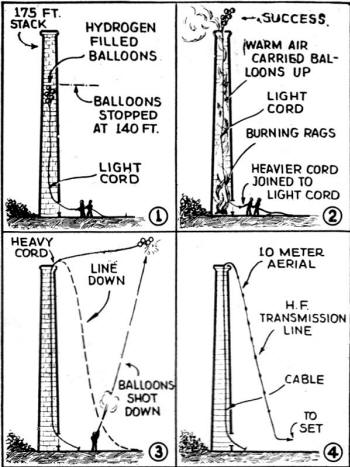|
October 1935 Short Wave Craft
 [Table
of Contents] [Table
of Contents]
Wax nostalgic about and learn from the history of early electronics. See articles
from Short Wave Craft,
published 1930 - 1936. All copyrights hereby acknowledged.
|
Antennas have been deployed
in difficult environments using many ingenious methods over the years both by professionals
and amateurs. The process typically involves first propelling a lightweight string
or wire across and/or up to a supporting structure (a tower, tree, building, whatever)
and then using that lead line to draw the antenna and its accompanying coaxial or
twin lead cable into its final position. Sometimes simply tying a line to a rock
and tossing it over a tree branch does the trick, but usually deployment requires
a more powerful launch such as a a bow and arrow or even a model rocket. Many years
ago R/C Modeler magazine reported on a large radio controlled airplane
(Senior Telemaster*)
that towed a lead line across a wide gulch in the mountains. Because the distance
was so great, a pilot was stationed on each side of the gulch, each with a transmitter
on the aircraft's frequency (72 MHz PCM was the modulation mode back then).
Upon walkie-talkie signaling, the takeoff pilot switched off his transmitter and
the landing pilot switch his on. The project was a success. This story reports on
yet another deployment method that involved a bit of extra thinking to complete
the project when the balloons refused to go all the way up the smoke stack. Shooting
down the balloons would be frowned upon these days, especially in a populated area. Here
is a QST article titled "More on Balloon-Supported Antennas."
* I couldn't find the article, but here's a statement from
Hobby Lobby (not the craft store) owner
Jim Martin in reference to it.
Balloons Raise S-W Antenna
|

Various stages in "balloon hoisted" aerial erection.
|
One of the most interesting problems ever to confront a radio construction engineer
was recently encountered in Chicago Heights, Ill., when a new "RCA Terra Wave" transmitter
was to be installed for transmitting police calls on ultra short waves, 30,100 kc.,
with call letters W9XGD.
A 175-foot brick smoke stack was handy for the purpose of supporting the aerial
but as a professional steeple jack was not available at the time, the difficulty
of getting the cable up through the 175-foot stack proved a poser.
It was finally decided that five balloons, each 16 inches in diameter, and filled
with hydrogen, would raise an ordinary chalk line up through the stack. The balloons
only rose to a height of 140 feet and after considering that the cooler draft of
air inside the stack had contracted the gas in the balloons somewhat, it was decided
to burn a few oil-soaked rags in the bottom of the stack. The warm air did the trick!
A heavier line was spliced onto the cord and allowed to run out through the top
of the stack. How do you think the balloons were cut loose from the cord after a
sufficiently heavy line was drawn up through the stack? Simple! A police sharp-shooter
shot the balloons down and when the cord settled to earth, a heavier rope was pulled
out through the top of the stack and finally a stranded copper wire cable was drawn
into place, to serve as a permanent anchor for the police radio antenna. - Courtesy
"Broadcast News."
Posted April 19, 2019
(updated from original post on
1/21/2015)
|










